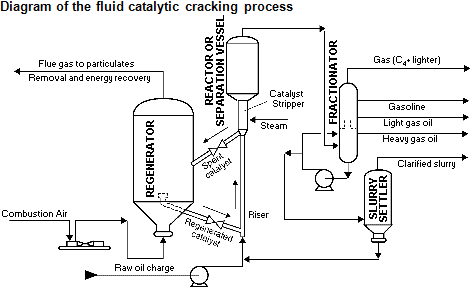Fluid catalytic cracking Plant
Contents
Background
The process of the FCC unit consists of the feed injection system, riser, riser outlet separator system, disengager/stripper, regenerator, catalyst cooler (optional), catalyst withdrawal well, catalyst transfer lines, and control systems.
The feed mixture is pumped to the base of the riser and divided into equal flows, to each of the feed nozzles. The feed, which has been preheated, is finely atomized and mixed with dispersion steam in the feed nozzles and injected into the riser. The small droplets of feed contact hot regenerated catalyst in a counter-current way and vaporize immediately. The vaporized oil intimately mixes with the catalyst particles and cracks into lighter, more valuable products along with slurry oil, coke, and gas. The product vapors travel up the riser while carrying the catalyst. Residence time in the riser is approximately 2 seconds at design conditions. The specially designed feed injection system ensures the reaction is carried out efficiently to minimize the production of coke, gas, and slurry oil.
Feed injection zone
Oil feed to the riser is preheated before entering the reaction system. Preheat temperature along with regenerated catalyst temperature is controlled to result in an optimum catalyst to oil ratio. Passivator injection into the fresh feed just ahead of the feed nozzles acts to inhibit the undesirable effects
Dispersion steam is supplied to each of the feed nozzles to promote atomization and vaporization of the feed. The flow to each of the feed nozzles is adjusted by flow controllers.
Upstream the feed injection, stabilization steam is injected in the riser, through the stabilization steam injectors, in order to promote a smooth and homogeneous catalyst flow at the feed injection point. The flow to each of the injectors is adjusted by flow controllers
Riser/Reactor
The sensible heat, heat of vaporization, and heat of reaction required by the feed is supplied by the hot regenerated catalyst. The riser outlet temperature is controlled by the amount of regenerated catalyst admitted to the riser through the regenerated catalyst slide valve. In the wye section at the base of the riser, steam is injected via a steam ring to keep the regenerated catalyst in a fluid state at all times.
The cracking reactions take place during the two-second residence time in the riser as the reaction mixture accelerates toward the Riser Outlet Separator System (ROSS).
The catalyst is quickly separated from the hydrocarbon/steam vapors in the ROSS separator located at the end of the riser. This separation is necessary to discourage the undesirable continuation of reactions that produce gas at the expense of gasoline.
This system drastically reduces the post riser catalyst/vapors contact time. After exiting the ROSS separator, the vapors pass through high efficiency single stage cyclones to complete the separation of catalyst from vapors, thus minimizing the amount of catalyst lost into the product.
The reactor pressure "floats on" the main fractionator pressure and as such is not directly controlled at the converter section. The ROSS separator and disengager cyclones separate the product vapors from the spent catalyst and return the catalyst to the stripper bed. The cyclone diplegs are equipped with trickle-valves to prevent reverse flow of gas up the diplegs. Also, the ROSS separator is equipped with diplegs fitted on its pre-stripping chambers. These diplegs are sealed into the stripper catalyst bed in order to avoid any possibility of vapors back mixing.
Stripper
Catalyst exiting the ROSS separator is pre-stripped with steam from a steam ring located immediately at the exit of the separator diplegs. This is an important feature for reducing coke yield. The catalyst is further stripped by steam from the main steam ring as the catalyst flows down the stripper.
Two additional rings (upper and lower rings) are also provided in addition to the main ring. The upper ring achieves the second stage of pre-stripping of the catalyst before it enters the stripper. The lower ring is located in the bottom head of the stripper to achieve stable fluidization at the inlet of the spent catalyst standpipe.
The contact between catalyst and steam is enhanced by the presence of fluidized bed packing allowing for cross and counter-current flow of steam and catalyst. This highly efficient contacting displaces the volatile hydrocarbons contained on and in the catalyst particles before they enter the first stage regenerator. Coke remaining on the catalyst is burned off in the regenerators. The catalyst is aerated in the spent catalyst standpipe to the proper density for stable head gain.
Spent catalyst transfer
The stripped spent catalyst flows down the spent catalyst standpipe and through the spent catalyst slide valve. Aeration by fuel gas (or nitrogen) is added to the standpipe at several elevations to maintain proper density and fluid characteristics of the spent catalyst emulsion. The spent catalyst slide valve controls the level in the stripper by regulating the flow of spent catalyst from the stripper. The spent catalyst flows into the first stage regenerator through a distributor which ensures that the entering coke-laden catalyst is spread across the regenerator bed.
